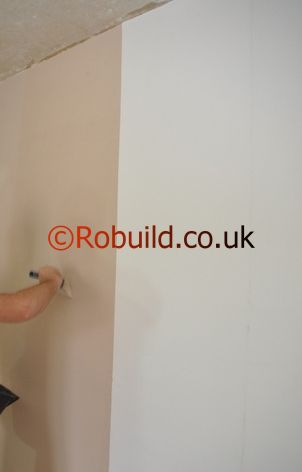Cutting the wallpaper

Unroll the wallpaper face (‘right’ side) upwards. Measure the length required and cut off 51-102mm (2-4in) below this (the additional amount is for easing the paper at the top and bottom). If the paper is patterned, find the first complete motif and cut off 25- 51mm (l-2in) above. Measure the length, and cut off 25-5.1 mm (1-2in) below. These extra amounts allow you to position the paper accurately, and to ease it in at the top and bottom. Cut the next length, checking that the pattern matches exactly at the top and sides, again allowing the additional inches at top and bottom. Lay the cut lengths on top of each other. Cut 2-3 lengths before pasting. Turn the pile over, so that the ‘wrong’ side now faces upwards, with the first cut length on top.
Pasting the wallpaper

Arrange the pile of paper centrally on the width of the pasting board, so that a little board shows on either side of the paper and the top edge of the paper is on your right. If the paper is longer than the board, have the overhang on your left. Push the top length only so that its far edge slightly overlaps the edge of the board. This is to avoid getting paste on to the board, and then on to the face of one of the other sheets. Apply a liberal brushful of paste along the centre of the length of the paper, and brush out to the far edge. Always brush outwards, as there is a danger of paste getting on to the face of the paper if you brush inwards.
Slide the paper towards you, so that the unpasted side now slightly overlaps the near side ol the board. Brush the paste from the centre to this edge. When the length on the table has been pasted, lift both the corners on the right edge and bring them over to make a large fold, without creasing (the pasted sides will be facing). Gently draw the paper along the table until the unpasted portion is flush with the left-hand edge of the board. Paste this length as before and then bring this section over and down to meet the first fold. As each length is pasted, place it on another table to ‘rest’. This lets the paste soak in-the time depends on manufacturers’ instructions-and the paper becomes supple.
Hanging the wallpaper
Lift the first length of paper over your arm and carry it to the wall. Unfold the top half and, holding the length carefully, place the top edge in position, easing it upwards until the 25-51mm (1-2in) excess overlaps at the top. Keep the side edge exactly level with the plumb line. If the corner is vertical, ease the paper into it exactly. Otherwise let it overlap into the corner. Smooth along the top of the piece with the paperhanger’s brush to hold it in place. Now smooth down the centre and out to the sides in a series of arrowhead motions. This movement eliminates air bubbles, and spreads the paste evenly on the wall. Don’t brush from side to side, as this could move the paper out of position.
Try not to over handle or stretch the paper. If any paste seeps out from the sides of the paper, wipe it off with a rag. Keep the paperhanger’s brush completely clean, and don’t let any paste get on to the ‘right’ side of the paper. Check again for correct placing, then unfold the bottom section and smooth it out, brushing it as before, until the whole length is completely flat without creases or blisters. The bottom edge will overlap the skirting board. Run the back edge of the scissors along the paper into the angle between the wall and the cornice or picture rail. Ease the top of the paper from the wall gently, and trim off the excess paper along the crease. Now repeat the procedure at the bottom, where the wall meets the skirting board. If you overlapped the paper into the corner, trim off the excess in a similar way. Smooth the paper back into position. Hang the next pieces of paper in the same way, butting the edges together (do not overlap them) and carefully matching the pattern. Run the seam roller down the joint when the paste is nearly dry.





